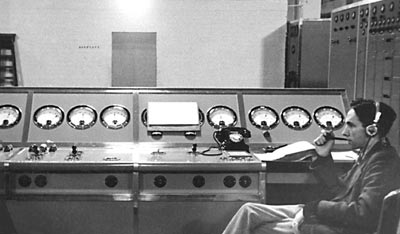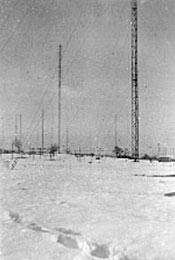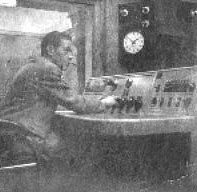
Roy with Biddy Baxter, later of "Blue Peter"
fame, creating the effect of a Mississippi paddle steamer in 1958.
The workshop of Crystal Drive Section was based in a small building in the grounds of Tatsfield Receiving Station. Our task overall was to make, assemble and test 50 Variable Frequency Oscillators (VFOs) for the BBC's short wave transmitters. My personal involvement apart from making the tea and sweeping up the workshop also included bench and lathe work, and assisting in assembling the units, which started as a smallish brass box housing the oscillating components with tuning controls, which in turn went into a bigger copper "box" with insulated heating elements around the outside, which again went into a similar larger copper box, then the whole assembly went into a very large wooden "box", finishing as a complete unit measuring (if I recall correctly) about 2ft 6in x 2ft 6in x 2ft - enormous when you consider the size of components today.
For the position of Workshop Assistant (grade 2) I received the princely wage of 19/6 plus 6/6 cost of living allowance per week. A total of £1. 6s 0d. Tatsfield is situated in the Biggin Hill area of North Kent. To get to the station one picked up by the BBC transport in Warlingham Surrey, at 0830 and leaving Tatsfield for the return journey at 1730 Monday to Friday. As Saturday was my half day finishing at 12:30, I had to cycle to work, a 16 mile round trip.
In 1944, after "D" day, the Germans started sending over flying bombs that were dubbed "Doodle Bugs". Several dropped around the Tatsfield area. Because of this the Frequency Checking Station was evacuated to Caversham. About 3 weeks later, after working underground at Tatsfield for this period, we in the Crystal Drive Section were moved to Nissen hut accommodation in the grounds of Washford transmitting station Somerset, to continue the VFO project.
Related page
In October 1945, W. E. C. Varley recommended that I go on the A1/B1 transmitter engineering course. This entailed one month in London and two months at Wood Norton in Evesham. I had a successful course and found myself in late December 1945 as a TA2 at Daventry Transmitter Station. My first assignment at Daventry was operating Senders 1 & 2, which were situated in a separate building from the main transmitting hall. They were the smallest Wattage T/Xs on site if my memory serves me right they were each 15KW. Sender 1 broadcast Arabic programmes in the Brown network. Sender 2 was used for a totally different job, sending service messages from UK to Nuremburg in Germany for the War Crime trials taking place in 1946. After 26 shillings a week it was nice to get £4: 10s instead.

Donald A. Smith at Daventry. He worked on Sender 10
during the war and later was editor of TV's "Children's Newsreel". He
also made several short films including "Chimpantics" and "London to
Brighton in 4 Minutes".
It was while I was on aerials during a night shift, riding around the site on a bicycle, slewing aerial arrays during frequency changes of shutdown transmitters, that one very dark night I heard a cough from behind, scaring the life out of me, only to find behind one of the sheep they kept on site to keep the grass down. Sheep have the most human cough imaginable. After the field work it was back to the Gantry area to link the transmitter to the new aerial array. It was then into the transmitter hall to give the T/X the OK to go on power again. Often as not the wave changes had to be done within 15 minutes. In the main hall during the wave change the T/X power had to be shut down. The T/X side doors opened to reach the "railway system" to take out the unwanted fixed tuned ccts and replace with the new one on trolleys on the railway. It was more than your life's worth to have a derailment, but it did happen once or twice, not by me I hasten to add. It was all hands to the pumps when it happened. Once you got clearance from aerials, you had to run up your T/X to full power fine tune your frequency ready for your next programme provided via the control room.

Daventry in the snow.
In 1948 I decided I wanted to work in London Control Room. I knew somebody there who wanted to return to Daventry. So we "conspired" to send transfer requests at the same time to EEO (Engineering Establishment Officer) and in April 1948 I found myself in LCR just in time for the 1948 Olympic games. I spent about a year in LCR manning numerous positions, bay one, Green network (General Overseas Service) distribution, Home service continuity in the CR area in the sub-basement and Light programme in the basement corridor approaching the then canteen area. Studio testing in the early morning was another job, which included testing the TD/7 grams. The number of times I played "The Teddy Bears Picnic" does not bear thinking about. Perhaps that was when I decided to join Programme Engineering. So it was in early 1949 I went on the course, and met Joe Latham.

On night shift, studio L2, Egton House, on Radio Newsreel.
1949.
Schools programmes were produced and transmitted live from Film House studios in Soho and later in a studio complex in 5 Portland Place. In 1951 until 1954 I joined Features department - this was possibly one of the most enjoyable periods of my BBC career. Features and Drama were based in Rothwell house, in New Cavendish Street. We were Studio Managers at this point, and the SSM Features was Laddie Ladbroke, assisted by Len Leighton. There were seven "other "ranks serving the production needs of twenty two producers. Producers such as Laurence Gilliam, Head of Features, Douglas Clevedon, Alan Burgess, Reggie Smith, Louis McNeice to name but a few. Prestigious broadcasts such as the Christmas Day Commonwealth round up programmes, finishing with the Monarch's message to the nation at 3:00pm, Dylan Thomas's "Under Milk Wood" with Richard Burton produced by Douglas Clevedon, the 1952 East coast floods produced by R. D. Smith, the Coronation 1953, a round up of the days events and the days preceding, all recorded on 12 inch, acetate coated aluminium discs. The live 2 hour evening transmission at 2000 on Coronation day was played on these Watts discs using "overlap" and "butt" change-overs and "jump" cuts. This method of studio production was the norm and carried out with fantastic manual dexterity by all SM staff at that period of time.

With Harry Rogers (later Station Manager Radio Kent
and OBE), carrying out studio effects on Mallory's "Morte Arthur",
1951.
"She dwelt unseen amid the lightSo my first 12 years in the BBC ended in a "blaze". After Features, I joined an elite unit called the General Duties Unit and dubbed the "commandos". Wherever there was a shortage of SM staff which could not be manned by normal staffing we were sent in to carry out the commitment.
among the Archer clan
and breathed her last the very night
that ITV began.
A maiden in a fantasy
All hidden from the eye
A spoken word; the BBC
decided she must die.
She was well loved and millions knew
that Grace had ceased to be
Now she is in her grave, but oh
she scooped the ITV."

Training new Studio Managers.
I had nearly 42 years full time service with the BBC and I think I can claim I enjoyed it. I had the support and encouragement of my wife Betty, who I married while I was with Features on 28th March 1953, 50 years ago.

